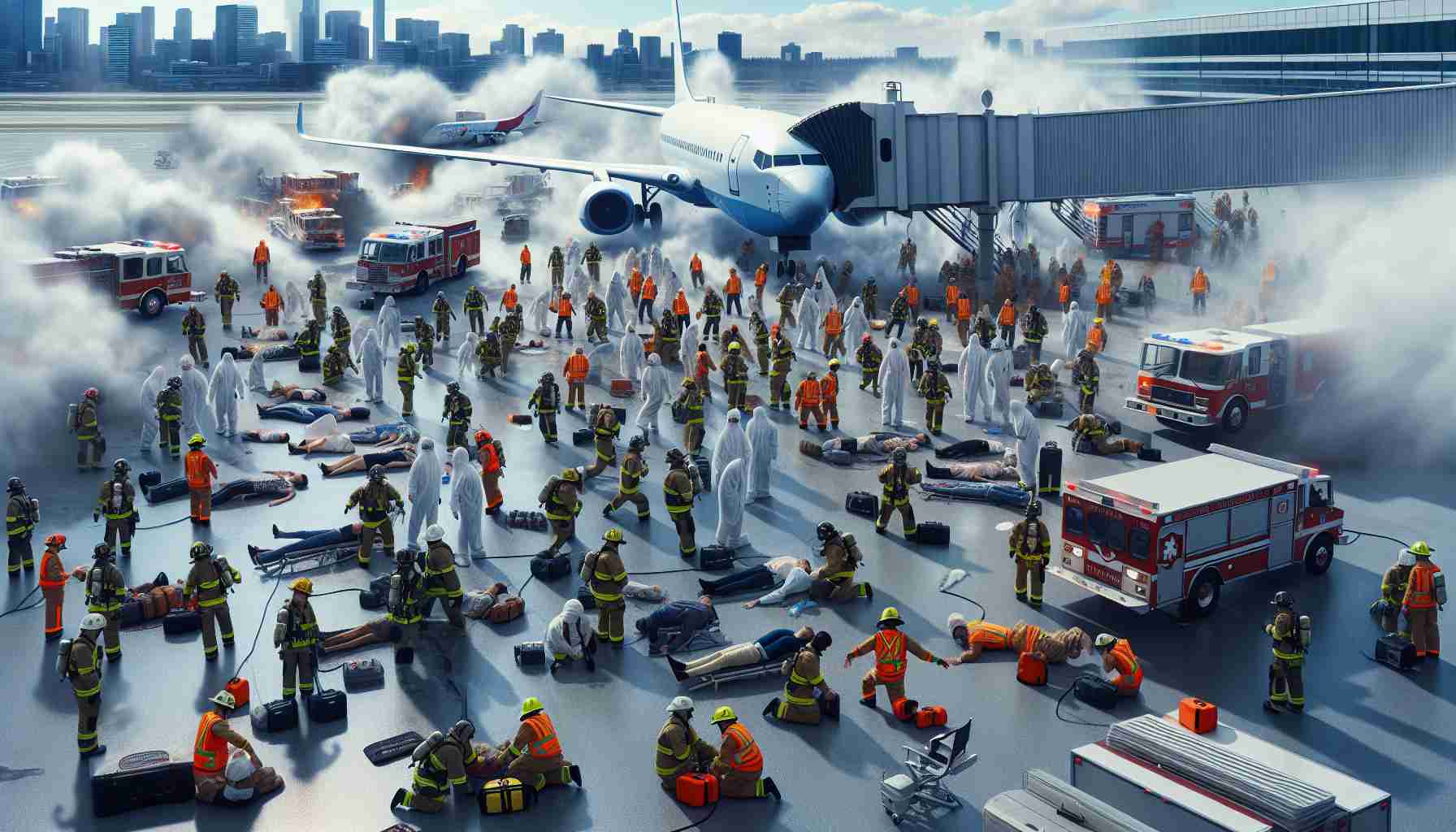- A significant aviation safety drill took place in Naha, simulating a tire burst incident during takeoff.
- Over 323 professionals from 58 organizations participated, highlighting a collaborative effort in emergency response.
- Key protocols like triage were practiced to improve treatment efficiency during a crisis.
- The airport administration aims to refine emergency responses based on insights gained from the drill.
- Naha Airport reaffirms its commitment to safety and security through regular training exercises.
- The drill emphasized the importance of readiness and communication in managing unexpected challenges.
- Other airports can learn valuable lessons from Naha’s proactive safety measures.
On a sunny day in Naha, a gripping aviation safety drill unfolded, simulating a catastrophic incident. Responding to an imagined nightmare where an aircraft’s tire burst during takeoff, leading it to plunge into the western sea, emergency responders sprang into action.
A remarkable team of 323 professionals from 58 different organizations, including airport personnel, firefighters, police, and medical experts, took part in this intense simulation. They practiced critical protocols like triage, prioritizing the treatment of injuries based on severity, and orchestrated a rapid response with air ambulances.
Throughout the exercise, participants demonstrated sheer determination to uphold safety standards at Naha Airport. The airport’s director emphasized their unwavering commitment to ensuring safety and security as a top priority. By conducting regular drills, they aim to enhance communication and coordination among all parties involved.
However, valuable insights emerged from this simulation. The airport administration identified areas for improvement in collaboration with medical institutions, underscoring their dedication to refining emergency responses.
This powerful training session not only prepared responders for potential disasters but also strengthened their resolve to protect lives. As Naha Airport continues to develop its safety protocols, the message is clear: readiness is key in the face of unexpected challenges. Airports across the globe can learn from these proactive measures, creating a safer environment for all travelers.
Unveiling the Future of Aviation Safety: Insights from Naha Airport’s Emergency Drill
Overview of the Simulation Exercise
On a bright day in Naha, an extensive aviation safety drill was conducted, simulating a dire situation where an aircraft experienced a tire burst during takeoff, resulting in a crash into the western sea. This drill engaged a dedicated team of 323 professionals from 58 organizations including airport staff, emergency services, and medical teams, demonstrating an extensive commitment to refining emergency protocols.
New Insights and Trends in Aviation Safety
1. Enhanced Inter-Agency Collaboration: The simulation revealed the necessity for improved coordination between airport authorities and medical institutions. The exercise underscored the importance of seamless communication channels in crisis scenarios, leading to better efficiency in real emergencies.
2. Focus on Mental Health and Psychological Support: Following incidents, not just physical injuries need addressing but also the psychological impact on both victims and responders. Modern emergency protocols are shifting towards holistic care that includes mental health resources.
3. Technological Innovations in Emergency Response: Incorporating advanced technology like drone surveillance and real-time data analytics can enhance situational awareness during disasters, aiding responders in making informed decisions and improving rescue operations.
Pros and Cons of Aviation Safety Drills
– Pros:
– Enhances preparedness and response strategies.
– Strengthens inter-agency collaboration and communication.
– Provides practical experience to professionals.
– Cons:
– Resource-intensive, requiring significant coordination and funding.
– Potential disruption to regular airport operations during drills.
– Risk of desensitization to emergency protocols among personnel if drills become too frequent.
Key Related Questions
1. What are the benefits of regular safety drills at airports?
Regular safety drills at airports enable personnel to practice and refine emergency procedures, ensuring readiness in actual crisis situations. They foster teamwork and improve inter-agency communication, ultimately enhancing passenger safety.
2. How can airports improve their emergency response capabilities?
Airports can improve their response capabilities by investing in technology, establishing robust communication channels with local healthcare facilities, and focusing on mental health support for both victims and responders.
3. What trends are emerging in aviation safety protocols?
Emerging trends in aviation safety include increased integration of technology (like drones and AI), emphasis on mental health support, and a strong focus on inter-agency collaboration to handle crises more effectively.
Conclusion
Naha Airport’s recent emergency drill not only illustrated the critical importance of preparedness in aviation safety but also highlighted areas for continued improvement and innovation. As the airport seeks to enhance its safety protocols, the lessons learned can serve as a model for airports globally, ensuring a safer environment for all travelers.
For more insights on aviation safety, visit ICAO.
